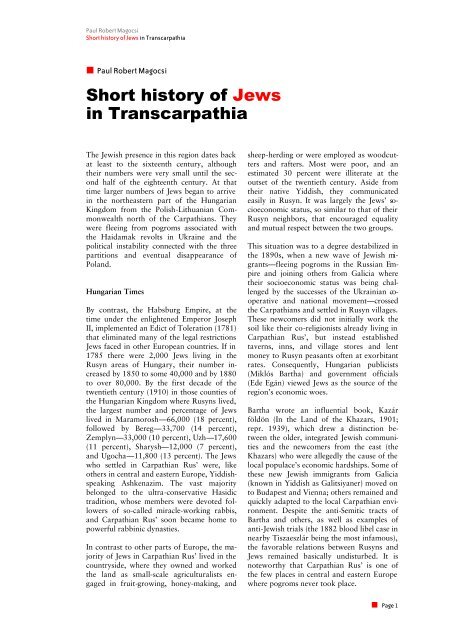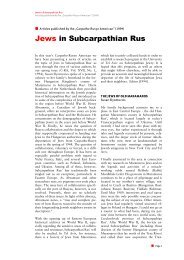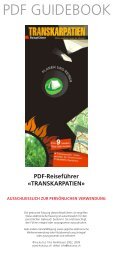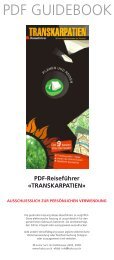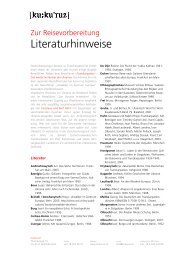Short history of Jews in Transcarpathia - kukuruz.ch
Short history of Jews in Transcarpathia - kukuruz.ch
Short history of Jews in Transcarpathia - kukuruz.ch
Create successful ePaper yourself
Turn your PDF publications into a flip-book with our unique Google optimized e-Paper software.
Paul Robert Magocsi<br />
<strong>Short</strong> <strong>history</strong> <strong>of</strong> <strong>Jews</strong> <strong>in</strong> <strong>Transcarpathia</strong><br />
� Paul Robert Magocsi<br />
<strong>Short</strong> <strong>history</strong> <strong>of</strong> <strong>Jews</strong><br />
<strong>in</strong> <strong>Transcarpathia</strong><br />
The Jewish presence <strong>in</strong> this region dates back<br />
at least to the sixteenth century, although<br />
their numbers were very small until the second<br />
half <strong>of</strong> the eighteenth century. At that<br />
time larger numbers <strong>of</strong> <strong>Jews</strong> began to arrive<br />
<strong>in</strong> the northeastern part <strong>of</strong> the Hungarian<br />
K<strong>in</strong>gdom from the Polish-Lithuanian Commonwealth<br />
north <strong>of</strong> the Carpathians. They<br />
were flee<strong>in</strong>g from pogroms associated with<br />
the Haidamak revolts <strong>in</strong> Ukra<strong>in</strong>e and the<br />
political <strong>in</strong>stability connected with the three<br />
partitions and eventual disappearance <strong>of</strong><br />
Poland.<br />
Hungarian Times<br />
By contrast, the Habsburg Empire, at the<br />
time under the enlightened Emperor Joseph<br />
II, implemented an Edict <strong>of</strong> Toleration (1781)<br />
that elim<strong>in</strong>ated many <strong>of</strong> the legal restrictions<br />
<strong>Jews</strong> faced <strong>in</strong> other European countries. If <strong>in</strong><br />
1785 there were 2,000 <strong>Jews</strong> liv<strong>in</strong>g <strong>in</strong> the<br />
Rusyn areas <strong>of</strong> Hungary, their number <strong>in</strong>creased<br />
by 1850 to some 40,000 and by 1880<br />
to over 80,000. By the first decade <strong>of</strong> the<br />
twentieth century (1910) <strong>in</strong> those counties <strong>of</strong><br />
the Hungarian K<strong>in</strong>gdom where Rusyns lived,<br />
the largest number and percentage <strong>of</strong> <strong>Jews</strong><br />
lived <strong>in</strong> Maramorosh—66,000 (18 percent),<br />
followed by Bereg—33,700 (14 percent),<br />
Zemplyn—33,000 (10 percent), Uzh—17,600<br />
(11 percent), Sharysh—12,000 (7 percent),<br />
and Ugo<strong>ch</strong>a—11,800 (13 percent). The <strong>Jews</strong><br />
who settled <strong>in</strong> Carpathian Rus’ were, like<br />
others <strong>in</strong> central and eastern Europe, Yiddishspeak<strong>in</strong>g<br />
Ashkenazim. The vast majority<br />
belonged to the ultra-conservative Hasidic<br />
tradition, whose members were devoted followers<br />
<strong>of</strong> so-called miracle-work<strong>in</strong>g rabbis,<br />
and Carpathian Rus’ soon became home to<br />
powerful rabb<strong>in</strong>ic dynasties.<br />
In contrast to other parts <strong>of</strong> Europe, the majority<br />
<strong>of</strong> <strong>Jews</strong> <strong>in</strong> Carpathian Rus’ lived <strong>in</strong> the<br />
countryside, where they owned and worked<br />
the land as small-scale agriculturalists engaged<br />
<strong>in</strong> fruit-grow<strong>in</strong>g, honey-mak<strong>in</strong>g, and<br />
sheep-herd<strong>in</strong>g or were employed as woodcutters<br />
and rafters. Most were poor, and an<br />
estimated 30 percent were illiterate at the<br />
outset <strong>of</strong> the twentieth century. Aside from<br />
their native Yiddish, they communicated<br />
easily <strong>in</strong> Rusyn. It was largely the <strong>Jews</strong>’ socioeconomic<br />
status, so similar to that <strong>of</strong> their<br />
Rusyn neighbors, that encouraged equality<br />
and mutual respect between the two groups.<br />
This situation was to a degree destabilized <strong>in</strong><br />
the 1890s, when a new wave <strong>of</strong> Jewish migrants—flee<strong>in</strong>g<br />
pogroms <strong>in</strong> the Russian Empire<br />
and jo<strong>in</strong><strong>in</strong>g others from Galicia where<br />
their socioeconomic status was be<strong>in</strong>g <strong>ch</strong>allenged<br />
by the successes <strong>of</strong> the Ukra<strong>in</strong>ian cooperative<br />
and national movement—crossed<br />
the Carpathians and settled <strong>in</strong> Rusyn villages.<br />
These newcomers did not <strong>in</strong>itially work the<br />
soil like their co-religionists already liv<strong>in</strong>g <strong>in</strong><br />
Carpathian Rus’, but <strong>in</strong>stead established<br />
taverns, <strong>in</strong>ns, and village stores and lent<br />
money to Rusyn peasants <strong>of</strong>ten at exorbitant<br />
rates. Consequently, Hungarian publicists<br />
(Miklós Bartha) and government <strong>of</strong>ficials<br />
(Ede Egán) viewed <strong>Jews</strong> as the source <strong>of</strong> the<br />
region’s economic woes.<br />
Bartha wrote an <strong>in</strong>fluential book, Kazár<br />
földön (In the Land <strong>of</strong> the Khazars, 1901;<br />
repr. 1939), whi<strong>ch</strong> drew a dist<strong>in</strong>ction between<br />
the older, <strong>in</strong>tegrated Jewish communities<br />
and the newcomers from the east (the<br />
Khazars) who were allegedly the cause <strong>of</strong> the<br />
local populace’s economic hardships. Some <strong>of</strong><br />
these new Jewish immigrants from Galicia<br />
(known <strong>in</strong> Yiddish as Galitsiyaner) moved on<br />
to Budapest and Vienna; others rema<strong>in</strong>ed and<br />
quickly adapted to the local Carpathian environment.<br />
Despite the anti-Semitic tracts <strong>of</strong><br />
Bartha and others, as well as examples <strong>of</strong><br />
anti-Jewish trials (the 1882 blood libel case <strong>in</strong><br />
nearby Tiszaeszlár be<strong>in</strong>g the most <strong>in</strong>famous),<br />
the favorable relations between Rusyns and<br />
<strong>Jews</strong> rema<strong>in</strong>ed basically undisturbed. It is<br />
noteworthy that Carpathian Rus’ is one <strong>of</strong><br />
the few places <strong>in</strong> central and eastern Europe<br />
where pogroms never took place.<br />
� Page 1
Paul Robert Magocsi<br />
<strong>Short</strong> <strong>history</strong> <strong>of</strong> <strong>Jews</strong> <strong>in</strong> <strong>Transcarpathia</strong><br />
Cze<strong>ch</strong>oslovak State<br />
With the collapse <strong>of</strong> Austria-Hungary <strong>in</strong> late<br />
1918, and the <strong>in</strong>corporation <strong>of</strong> Subcarpathian<br />
Rus’ and the Prešov Region <strong>in</strong>to<br />
Cze<strong>ch</strong>oslovakia, Jewish life was to be significantly<br />
<strong>in</strong>fluenced by the democratic and secular<br />
environment promoted by the new state.<br />
The demographic and socioeconomic status<br />
<strong>of</strong> <strong>Jews</strong> did not <strong>ch</strong>ange mu<strong>ch</strong>. In Subcarpathian<br />
Rus’ their numbers <strong>in</strong>creased to<br />
102,500 (1930), whi<strong>ch</strong> represented 14 percent<br />
<strong>of</strong> the prov<strong>in</strong>ce’s population. Over twothirds<br />
still lived <strong>in</strong> rural areas and over half<br />
supported themselves through manual labor<br />
(as agriculturalists, shepherds, wagon workers,<br />
artisans). On the other hand, <strong>Jews</strong> comprised<br />
more than 20 percent <strong>of</strong> the <strong>in</strong>habitants<br />
<strong>in</strong> as many as 37 small towns and cities.<br />
They were particularly dom<strong>in</strong>ant <strong>in</strong> places<br />
like Solotvyno (44 percent), Bushtyno-<br />
Buzh<strong>ch</strong>yns’kyi Handal (36 percent), Irshava<br />
(36 percent), and <strong>in</strong> Sighet (38 percent),<br />
whi<strong>ch</strong> after the war was <strong>in</strong>corporated <strong>in</strong>to<br />
Romania. However, Muka<strong>ch</strong>evo (43 percent<br />
Jewish) with its suburb Rosvygovo (38 percent)<br />
rema<strong>in</strong>ed the largest community as well<br />
as the cultural and spiritual center <strong>of</strong> Subcarpathia’s<br />
Jewry.<br />
Under Cze<strong>ch</strong>oslovak rule <strong>Jews</strong> were for the<br />
first time recognized as a dist<strong>in</strong>ct nationality,<br />
with 95,000 claim<strong>in</strong>g themselves as su<strong>ch</strong> out<br />
<strong>of</strong> 102,000 <strong>of</strong> the Jewish faith (1930). The<br />
government also encouraged secular education,<br />
whi<strong>ch</strong> was gratis <strong>in</strong> state s<strong>ch</strong>ools. In the<br />
pre-World War I era a small percentage <strong>of</strong><br />
the community, especially urban <strong>Jews</strong>, attended<br />
Hungarian-language s<strong>ch</strong>ools; most,<br />
however, received their education at the Jewish<br />
kheyder (elementary s<strong>ch</strong>ools), the yeshiva<br />
(higher s<strong>ch</strong>ools, or academies for the study <strong>of</strong><br />
the Talmud), or the beis medresh (houses <strong>of</strong><br />
religious study for adults). These Jewish<br />
s<strong>ch</strong>ools were supported by the local communities,<br />
and some, su<strong>ch</strong> as the yeshiva headed<br />
by Rabbi Josef Meir Weiss <strong>in</strong> Muka<strong>ch</strong>evo<br />
ga<strong>in</strong>ed a reputation for excellence <strong>in</strong> Talmudic<br />
studies that attracted students from other<br />
communities. Under Cze<strong>ch</strong>oslovak rule the<br />
number <strong>of</strong> Jewish students <strong>in</strong> Hungarian<br />
s<strong>ch</strong>ools decl<strong>in</strong>ed further, and students from<br />
the Orthodox religious s<strong>ch</strong>ools began to attend<br />
<strong>in</strong> ever-<strong>in</strong>creas<strong>in</strong>g numbers state-run<br />
Rusyn-language and later Cze<strong>ch</strong>-language<br />
elementary and secondary s<strong>ch</strong>ools. By the<br />
mid-1920s only 7 percent <strong>of</strong> the estimated<br />
13,000 Jewish student population attended<br />
the seven Hebrew-language elementary<br />
s<strong>ch</strong>ools and one gymnasium <strong>in</strong> Muka<strong>ch</strong>evo (a<br />
second was opened <strong>in</strong> Uzhhorod <strong>in</strong> 1934).<br />
Tradition and Modernism<br />
Aside from the secular <strong>in</strong>cursion <strong>of</strong> the<br />
Cze<strong>ch</strong>oslovak state <strong>in</strong>to traditional Jewish<br />
society, the Orthodox Hasidic majority was<br />
<strong>ch</strong>allenged by a rapidly grow<strong>in</strong>g Zionist<br />
movement that made its first appearance <strong>in</strong><br />
the Subcarpathian region after World War I.<br />
The movement was led by Hayyim/Chaim<br />
Kugel (1897-1966), a native <strong>of</strong> M<strong>in</strong>sk <strong>in</strong> the<br />
Russian Empire who had gone to study <strong>in</strong><br />
Prague <strong>in</strong> 1920 and who arrived <strong>in</strong> Muka<strong>ch</strong>evo<br />
soon after. The Zionists promoted<br />
the need for modern education conducted <strong>in</strong><br />
Hebrew, whi<strong>ch</strong> was <strong>in</strong>tended to prepare<br />
young people for their ultimate goal, emigration<br />
(aliyah) to Palest<strong>in</strong>e, that is, the ancient<br />
Jewish land <strong>of</strong> Israel (Eretz Israel). They also<br />
adamantly rejected the Hasidic life-style,<br />
whi<strong>ch</strong> they considered to be reactionary and<br />
superstitious. In response, the Orthodox castigated<br />
the Zionists and their <strong>in</strong>stitutions,<br />
su<strong>ch</strong> as the Hebrew gymnasium <strong>in</strong> Muka<strong>ch</strong>evo,<br />
whi<strong>ch</strong> one Hasidic rabbi described<br />
as “a place from whi<strong>ch</strong> come out heretics<br />
pure and simple who deny the Torah.”<br />
The Hasidic-Zionist conflicts spilled over <strong>in</strong>to<br />
politics. Dur<strong>in</strong>g the last years <strong>of</strong> Austro-<br />
Hungarian rule Hungarian-speak<strong>in</strong>g <strong>Jews</strong><br />
liv<strong>in</strong>g <strong>in</strong> urban areas were attracted to the<br />
left-w<strong>in</strong>g socialist movement. Several played<br />
an active role <strong>in</strong> the 1919 revolution <strong>of</strong> Béla<br />
Kun that created a Communist regime <strong>in</strong><br />
Hungary and Soviet Rus’ka Kraïna (Arm<strong>in</strong><br />
Dezso, Herman Fejér/Feier, Ene Hamburger,<br />
Béla Illés, Erno Seidler, Moszes Simon), and<br />
most jo<strong>in</strong>ed the International Socialist and<br />
Communist parties <strong>in</strong> Subcarpathian Rus’<br />
after the prov<strong>in</strong>ce was united with Cze<strong>ch</strong>oslovakia.<br />
As supporters <strong>of</strong> an ideology that<br />
espoused atheism, these <strong>in</strong>dividuals more<br />
<strong>of</strong>ten than not rejected or even denied their<br />
Jewish heritage. The Subcarpathian Communist<br />
party did, however, cont<strong>in</strong>ue to attract<br />
Jewish voters throughout the <strong>in</strong>terwar years.<br />
The Cze<strong>ch</strong>oslovak era also witnessed the<br />
creation <strong>of</strong> specifically Jewish parties. In<br />
1919 an all-national Jewish party/Židovská<br />
strana was founded by Zionists <strong>in</strong> Prague. Its<br />
� Page 2
Paul Robert Magocsi<br />
<strong>Short</strong> <strong>history</strong> <strong>of</strong> <strong>Jews</strong> <strong>in</strong> <strong>Transcarpathia</strong><br />
lead<strong>in</strong>g activist <strong>in</strong> Subcarpathian Rus’ was<br />
Hayyim/Chaim Kugel, and the party was<br />
supported by press organs published <strong>in</strong> both<br />
Hungarian, Zsidó néplap (1919-38), and<br />
Yiddish, Yudishe Shtimme (1929-38). Although<br />
the Zionists were able to attract a<br />
portion <strong>of</strong> the Orthodox Hasidim, especially<br />
among the younger generation, their party<br />
was able to elect its own deputy from Subcarpathian<br />
Rus’ to the Cze<strong>ch</strong>oslovak parliament<br />
(Kugel, <strong>in</strong> 1935) only after it jo<strong>in</strong>ed <strong>in</strong><br />
an electoral coalition with the Cze<strong>ch</strong>oslovak<br />
Social-Democratic party.<br />
Initially, the Orthodox <strong>Jews</strong> es<strong>ch</strong>ewed direct<br />
participation <strong>in</strong> electoral politics and <strong>in</strong>stead<br />
established a Jewish Central Bureau, recognized<br />
by the Cze<strong>ch</strong>oslovak government,<br />
whose political leaders were to be designated<br />
by the <strong>in</strong>fluential rabbis. When, however, the<br />
Zionists began to solicit support among the<br />
<strong>Jews</strong> <strong>in</strong> rural areas the Orthodox leaders<br />
created their own Orthodox Jewish<br />
party/Židovská strana orthodoxní, headed by<br />
Sándor/Alexander Kroó (1885-19??). The<br />
Orthodox party at times entered <strong>in</strong>to a coalition<br />
with the Cze<strong>ch</strong>oslovak Agrarian/Republican<br />
party (although it never had<br />
its own deputy <strong>in</strong> the national parliament); at<br />
other times it campaigned <strong>in</strong>dependently <strong>in</strong><br />
local and municipal elections, support<strong>in</strong>g<br />
autonomy for Subcarpathian Rus’. With regard<br />
to voter preference <strong>in</strong> general, the largest<br />
percentage <strong>of</strong> <strong>Jews</strong>, like Rusyns, supported<br />
the Communist party.<br />
Aside from their problems with the Zionists,<br />
the Hasidim were deeply divided by <strong>in</strong>ternal<br />
conflicts caused largely by personal rivalries<br />
among their <strong>ch</strong>arismatic and authoritarian<br />
rabbis, ea<strong>ch</strong> <strong>of</strong> whom felt obliged to defend<br />
the <strong>in</strong>terests—and righteousness—<strong>of</strong> their<br />
respective dynasties. Among these were the<br />
Sp<strong>in</strong>ka Hasidim headed by Rabbi Josef Meir<br />
Weiss (1839-1909) and his son Isaac/Eizik<br />
Weiss (1875-1944) <strong>in</strong> Muka<strong>ch</strong>evo and the<br />
Sziget-Satmar Hasidim led by Rabbi Joel<br />
Teitelbaum (1886-1979), based <strong>in</strong> Satu Mare<br />
just across the border <strong>in</strong> Romania. But the<br />
most passionate feud<strong>in</strong>g took place between<br />
the region’s most powerful rabbi, Hayyim<br />
Eleazar Shapira/Spira (1871-1937) <strong>of</strong> Muka<strong>ch</strong>evo,<br />
supported by the Yiddish-language<br />
newspaper Yidishe Tsaytung (1927-??), and<br />
Rabbi Issa<strong>ch</strong>ar Dov Rokeah (1854-1927), a<br />
World War I refugee from Belz <strong>in</strong> Galicia,<br />
who <strong>in</strong> 1918 settled and soon attracted a<br />
large follow<strong>in</strong>g <strong>in</strong> Subcarpathian Rus’. A<br />
bitter rivalry for control over the region’s<br />
Hasidic community cont<strong>in</strong>ued between the<br />
two men until 1923, when Rabbi Spira succeeded<br />
<strong>in</strong> conv<strong>in</strong>c<strong>in</strong>g the Cze<strong>ch</strong> authorities to<br />
expel his Belz rival from the country.<br />
Destruction<br />
Despite the a<strong>ch</strong>ievements <strong>in</strong> education and<br />
<strong>in</strong>creased Jewish participation <strong>in</strong> political life,<br />
the Cze<strong>ch</strong>oslovak regime was not able to<br />
improve <strong>in</strong> any significant manner the poor<br />
economic status <strong>of</strong> most <strong>Jews</strong>. Their economic<br />
conditions, like those <strong>of</strong> the Rusyns,<br />
only worsened dur<strong>in</strong>g the 1930s, follow<strong>in</strong>g<br />
the negative impact <strong>of</strong> the worldwide economic<br />
depression on Subcarpathian society.<br />
This decade also witnessed the growth <strong>of</strong><br />
small Rusyn-owned bus<strong>in</strong>esses and cooperatives<br />
whi<strong>ch</strong> <strong>ch</strong>allenged the previous Jewish<br />
dom<strong>in</strong>ance <strong>of</strong> retail trade. The resultant economic<br />
rivalry led at times to boycotts and to<br />
verbal friction <strong>in</strong> the press. F<strong>in</strong>ally, <strong>Jews</strong> became<br />
concerned with the growth <strong>of</strong> the<br />
Ukra<strong>in</strong>ian national movement, whi<strong>ch</strong> rea<strong>ch</strong>ed<br />
its culm<strong>in</strong>ation dur<strong>in</strong>g the few months <strong>of</strong><br />
Subcarpathian autonomy (October-Mar<strong>ch</strong><br />
1939). The presence dur<strong>in</strong>g that time <strong>of</strong> émigré<br />
activists from the Organization <strong>of</strong> Ukra<strong>in</strong>ian<br />
Nationalists (mostly from Galicia), the<br />
<strong>in</strong>creas<strong>in</strong>g authoritarian nature <strong>of</strong> Carpatho-<br />
Ukra<strong>in</strong>e’s government, and the sympathy <strong>of</strong><br />
some <strong>of</strong> its leaders toward Nazi Germany did<br />
not bode well for the Jewish population.<br />
With the destruction <strong>of</strong> Cze<strong>ch</strong>oslovakia <strong>in</strong><br />
Mar<strong>ch</strong> 1939 and the annexation <strong>of</strong> Subcarpathian<br />
Rus’ and a part <strong>of</strong> the Prešov Region<br />
(as far as Sn<strong>in</strong>a) by Hungary the status <strong>of</strong><br />
<strong>Jews</strong> steadily worsened. The Hungarian government<br />
immediately made a dist<strong>in</strong>ction between<br />
local <strong>Jews</strong> and the “aliens” from the<br />
East; eventually, the latter <strong>in</strong>cluded those<br />
who had arrived <strong>in</strong> the region after 1850.<br />
Subcarpathia’s <strong>Jews</strong> were also subject to<br />
Hungary’s anti-Jewish laws (1938 and 1939),<br />
whi<strong>ch</strong> placed restrictions on employment<br />
(<strong>in</strong>clud<strong>in</strong>g exclusion from the civil service and<br />
armed forces) and on access to s<strong>ch</strong>ools. Subsequent<br />
decrees (1942) deprived religious<br />
communities <strong>of</strong> their legal status and provided<br />
for expropriation <strong>of</strong> Jewish-owned<br />
farms and forest lands. In response to this<br />
ever-worsen<strong>in</strong>g situation, young <strong>Jews</strong> began<br />
to flee the region. Some went to western<br />
� Page 3
Paul Robert Magocsi<br />
<strong>Short</strong> <strong>history</strong> <strong>of</strong> <strong>Jews</strong> <strong>in</strong> <strong>Transcarpathia</strong><br />
Europe, eventually rea<strong>ch</strong><strong>in</strong>g France and Brita<strong>in</strong><br />
(like the future British publicist and<br />
newspaper magnate Robert Maxwell (Ludvik<br />
Ho<strong>ch</strong> from Solotvyno) or to Israel. Others<br />
crossed the Carpathians <strong>in</strong>to what after September<br />
1939 was the Soviet Union, where<br />
they, with fellow Rusyns, were promptly<br />
arrested and imprisoned <strong>in</strong> the Gulag until<br />
their release <strong>in</strong> 1943 to jo<strong>in</strong> the Cze<strong>ch</strong>oslovak<br />
Army Corps fight<strong>in</strong>g alongside the Soviets.<br />
Hungary’s policy <strong>of</strong> legal restrictions was<br />
gradually replaced by one <strong>of</strong> physical expulsion.<br />
The first stage occurred <strong>in</strong> July 1941,<br />
when “alien” <strong>Jews</strong> (many <strong>of</strong> whom had only<br />
recently arrived as refugees from former Poland)<br />
as well as some Subcarpathian <strong>Jews</strong>,<br />
together number<strong>in</strong>g about 20,000, were<br />
forcibly deported to eastern Galicia, whi<strong>ch</strong><br />
had just been annexed to Nazi Germany.<br />
Almost immediately German SS units killed<br />
over half <strong>of</strong> them at Kamianets’-Podil’s’k. For<br />
most <strong>of</strong> the rest <strong>of</strong> the war the Hungarian<br />
government under Miklós Horthy resisted<br />
deport<strong>in</strong>g its “own” non-alien <strong>Jews</strong>, but after<br />
the German army entered Hungary Budapest<br />
was forced to comply with Nazi demands for<br />
deportation. In April 1944 Subcarpathia’s<br />
<strong>Jews</strong> were rounded up and placed <strong>in</strong> temporary<br />
ghettos established (<strong>in</strong> several cases <strong>in</strong><br />
brick factories) <strong>in</strong> Muka<strong>ch</strong>evo, Uzhhorod,<br />
Khust, Vynohradovo/Sevliush, and Berehovo.<br />
Over a period <strong>of</strong> three weeks (May 15-June<br />
7, 1944) virtually the entire Jewish population<br />
(116,000 as <strong>of</strong> 1941) was deported to<br />
Aus<strong>ch</strong>witz, where they were killed <strong>in</strong> the gas<br />
<strong>ch</strong>ambers upon arrival. In Slovakia some<br />
<strong>Jews</strong> were deported as early as 1942, although<br />
those liv<strong>in</strong>g <strong>in</strong> the Rusyn-<strong>in</strong>habited<br />
Prešov Region rema<strong>in</strong>ed until the spr<strong>in</strong>g <strong>of</strong><br />
1944, when they, too, were sent to the<br />
Aus<strong>ch</strong>witz death camp. With regard to the<br />
reaction <strong>of</strong> the local Rusyn population to the<br />
deportations, there are reports <strong>of</strong> <strong>in</strong>tervention<br />
to save <strong>Jews</strong> as well as reports <strong>of</strong> cooperation<br />
with the Hungarian authorities.<br />
After the Holocaust<br />
At the end <strong>of</strong> World War II it was estimated<br />
that no more than 20 percent (25,000) <strong>of</strong> the<br />
Subcarpathian <strong>Jews</strong> had survived. They <strong>in</strong>cluded<br />
those liberated from concentration<br />
camps, those who hid <strong>in</strong> Budapest dur<strong>in</strong>g the<br />
last months <strong>of</strong> the war, and soldiers who had<br />
fled to the Soviet Union and served <strong>in</strong> the<br />
Cze<strong>ch</strong>oslovak Army Corps. Many returned<br />
home, but only briefly, to what was about to<br />
become Soviet-ruled <strong>Transcarpathia</strong>. Others<br />
emigrated to western Europe (like the future<br />
Nobel-Prize w<strong>in</strong>n<strong>in</strong>g author Elie Wiesel from<br />
Sighet), to the United States, and to Israel<br />
(<strong>in</strong>clud<strong>in</strong>g the Holocaust historian Livia<br />
Rothkir<strong>ch</strong>en from Vynohradovo/Sevliush).<br />
The Satmar Hasidic Rabbi Teitelbaum settled<br />
<strong>in</strong> New York City (the Williamsburg section<br />
<strong>of</strong> Brooklyn), where his followers cont<strong>in</strong>ue to<br />
ma<strong>in</strong>ta<strong>in</strong> a close-knit community, as do the<br />
followers <strong>of</strong> Rabbi Shapira/Spira <strong>of</strong> Muka<strong>ch</strong>evo,<br />
under the direction <strong>of</strong> his grandson,<br />
Rabbi Moishe Rab<strong>in</strong>ovit<strong>ch</strong>, based <strong>in</strong> the Boro<br />
Park Section <strong>of</strong> Brooklyn. Those who emigrated<br />
to Israel eventually set up religious and<br />
cultural centers, su<strong>ch</strong> as the Maramorosh<br />
House/Bet Maramarosh <strong>in</strong> Tel Aviv. The<br />
largest number <strong>of</strong> returnees took advantage<br />
<strong>of</strong> a supplemental clause <strong>in</strong> the Cze<strong>ch</strong>oslovak-<br />
Soviet Treaty <strong>of</strong> 1945 that allowed <strong>Jews</strong> from<br />
the former Subcarpathian Rus’ to opt for<br />
Cze<strong>ch</strong>oslovak citizenship. Between 1945 and<br />
1947 about 18,000 did so and were settled<br />
for the most part <strong>in</strong> the far western regions <strong>of</strong><br />
postwar Cze<strong>ch</strong>oslovakia (see Optatsiia). But<br />
even they did not rema<strong>in</strong> there for long. After<br />
the Communist coup <strong>of</strong> February 1948, all<br />
but about 2,000 Subcarpathian <strong>Jews</strong> left<br />
Cze<strong>ch</strong>oslovakia for Israel (1949-1950). In<br />
effect, the vibrant Jewish community that had<br />
once existed <strong>in</strong> Carpathian Rus’ came to an<br />
end follow<strong>in</strong>g the deportations and Holocaust<br />
<strong>of</strong> 1944 and the postwar emigration. In<br />
the late 1940s and 1950s <strong>Jews</strong> from other<br />
parts <strong>of</strong> the Soviet Union settled <strong>in</strong> <strong>Transcarpathia</strong><br />
(an estimated 7,000 <strong>in</strong> 1979), but<br />
most <strong>of</strong> these, too, left for Israel or the United<br />
States dur<strong>in</strong>g the wave <strong>of</strong> Jewish emigration<br />
from the Soviet Union <strong>in</strong> the 1970s.<br />
At present there are perhaps about 2,600<br />
<strong>Jews</strong> left <strong>in</strong> <strong>Transcarpathia</strong>. With<strong>in</strong> today’s<br />
<strong>in</strong>dependent Ukra<strong>in</strong>e this small community,<br />
made up exclusively <strong>of</strong> post-War II Jewish<br />
immigrants from various parts <strong>of</strong> the former<br />
Soviet Union, has s<strong>in</strong>ce the late 1980s experienced<br />
a revival. In 1993 a Jewish Cultural<br />
and Enlightenment Society was founded. It<br />
operates Sunday s<strong>ch</strong>ools <strong>in</strong> Yiddish and Hebrew<br />
and sponsors events promot<strong>in</strong>g Jewish<br />
culture. The Khesed Shpira Benevolent Fund<br />
publishes <strong>in</strong> Uzhhorod a Russian-language<br />
monthly magaz<strong>in</strong>e about Jewish life <strong>in</strong> present-day<br />
<strong>Transcarpathia</strong>.<br />
� Page 4
Paul Robert Magocsi<br />
<strong>Short</strong> <strong>history</strong> <strong>of</strong> <strong>Jews</strong> <strong>in</strong> <strong>Transcarpathia</strong><br />
Bibliography:<br />
František Friedmann, “Židovská národní menš<strong>in</strong>a na<br />
Podkarpatské Rusi,” Národnostní obzor, IV (Pra-<br />
gue, 1934), pp. 185-192 and 269-277<br />
V. Suk and Chaim Kugel, “Židé na Podkarpatské Rusi,”<br />
<strong>in</strong> Jaroslav Zatloukal, ed., Podkarpatská Rus (Bra-<br />
tislava, 1936), pp. 128-137 and 149-151;<br />
Jean Mousset, “Le problème juif en Russie subcarpathi-<br />
que,” Affaires étrangères, VIII, 8 (Paris, 1938), pp.<br />
501-512;<br />
Yehuda Erez, ed., Entsiklopedyah shel galuyot, Vol. VII:<br />
Karpatorus (Tel Aviv, 1959);<br />
Randolph L. Braham, “The Destruction <strong>of</strong> the <strong>Jews</strong> <strong>of</strong><br />
Carpatho-Ruthenia,” <strong>in</strong> idem, ed., Hungarian-<br />
Jewish Studies, Vol. I (New York, 1966), pp. 223-<br />
236;<br />
Aryeh Sole, “Subcarpathian Ruthenia, 1918-1938,” <strong>in</strong><br />
The <strong>Jews</strong> <strong>of</strong> Cze<strong>ch</strong>oslovakia, Vol. I (Philadelphia<br />
and New York, 1968), pp. 125-154;<br />
Hugo Stransky, “The Religious Life <strong>in</strong> Slovakia and<br />
Subcarpathian Ruthenia,” and Aryeh Sole, “Mod-<br />
ern Hebrew Education <strong>in</strong> Subcarpathian Ruthenia,”<br />
<strong>in</strong> ibid., Vol. II (1971), pp. 347-389 and 401-439;<br />
Livia Rothkir<strong>ch</strong>en, “Deep-Rooted Yet Alien: Some<br />
Aspects <strong>of</strong> the History <strong>of</strong> the <strong>Jews</strong> <strong>in</strong> Subcarpathian<br />
Ruthenia,” Yad Vashem Studies, XII (Jerusalem,<br />
1977), pp. 147-191;<br />
Herman Dicker, Piety and Perseverance: <strong>Jews</strong> from the<br />
Carpathian Mounta<strong>in</strong>s (New York, 1981);<br />
Tamás Majsai, “A korösmezei zsidódeportálás 1941-<br />
ben,” <strong>in</strong> A Ráday-gyujtemény évkönyve, Vol. IV-V<br />
(Budapest, 1986), pp. 59-89 and 197-237;<br />
Alexander Baran, “Jewish-Ukra<strong>in</strong>ian Relations <strong>in</strong> Tran-<br />
scarpathia,” <strong>in</strong> Peter J. Poti<strong>ch</strong>nyj and Howard As-<br />
ter, eds., Ukra<strong>in</strong>ian-Jewish Relations <strong>in</strong> Historical<br />
Perspective (Edmonton, 1988), pp. 159-170;<br />
Shlomo Rozman, Sefer Shafar harerei kedem: golat<br />
Karpatorus-Maramarosh be-tifertah u-vehurbanah,<br />
Vol. I (New York, 1991);<br />
Zydzi w Karpata<strong>ch</strong>: Beskid Niski, Bieszczady, Pogórze:<br />
krótki przewodnik (Warsaw, 1991);<br />
Harm Ramkema, “Joden <strong>in</strong> Roethenië: leven <strong>in</strong> een<br />
microkosmos,” <strong>in</strong> A.W.M. Gerrits and H. Ram-<br />
kama, eds., Het onvoltooide verleden (Utre<strong>ch</strong>t,<br />
1993), pp. 104-130;<br />
Allan L. Nadler, “The War on Modernity <strong>of</strong> R. Hayyim<br />
Elazar Shapira <strong>of</strong> Munkacz,” Modern Judaism,<br />
XIV, 3 (Baltimore, 1994), pp. 233-264;<br />
Yeshayahu A. Jel<strong>in</strong>ek, “Carpatho-Rus’ Jewry: The Last<br />
Cze<strong>ch</strong>oslovakian Chapter, 1944-1949,” Shvut, No.<br />
1-2 [17-18] (Tel Aviv, 1995), pp. 265-295;<br />
László Karsai, “Jewish Deportations <strong>in</strong> Carpatho-<br />
Ruthenia <strong>in</strong> 1944,” Acta Historica, CI (Szeged,<br />
1995), pp. 37-49;<br />
Jaroslav Vaculík, “Židé z Podkarpatské Rusi jako op-<br />
tanti pro ceskoslovenské státní obcanství v lete<strong>ch</strong><br />
1945-1947,” <strong>in</strong> Medz<strong>in</strong>árodní vedecká konference:<br />
Akce Nisko v historii ‘konecného rešení židovské<br />
otázky’ (Ostrava, 1995), pp. 292-300;<br />
Mykola Makara, “Hnani doleiu: etnosotsial’nyi narys<br />
istoriï ievreistva na Zakarpatti,” Karpats’kyi krai,<br />
V, 9-12 [112] (Uzhhorod, 1995), pp. 12-18;<br />
Judit Fejes, “On the History <strong>of</strong> the Mass Deportations<br />
from Carpatho-Ruthenia <strong>in</strong> 1941,” <strong>in</strong> Randolph L.<br />
Braham and Attila Pók, eds., The Holocaust <strong>in</strong><br />
Hungary Fifty Years Later (Boulder, Colo., 1997),<br />
pp. 305-328;<br />
Peter Konya, Dej<strong>in</strong>y Židov na vý<strong>ch</strong>odnom Slovensku<br />
(Prešov, 1997);<br />
Yeshayahu A. Jel<strong>in</strong>ek, “Jewish Youth <strong>in</strong> Carpatho-Rus’:<br />
Between Hope and Despair (1920-1938),” Shvut,<br />
No. 7 [23] (Tel Aviv, 1998), pp. 147-165.<br />
…………………………………………………………...<br />
Source: http://www.rusyn.org/pop_jews.htm<br />
� Page 5


